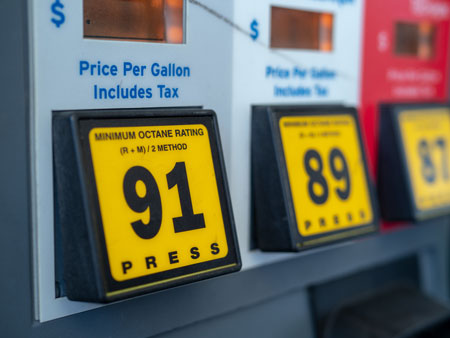When it comes to buying a used car in Australia, there are numerous factors to consider, such as mileage, condition, and model year, just to name a few. Another crucial but often overlooked aspect is the fuel octane rating. Understanding what octane ratings mean can enhance your driving experience and ensure the longevity of your vehicle’s engine.
What is the Fuel Octane Rating?
In simple terms, the octane rating of fuel indicates its resistance to knocking (also known as pinging) during combustion. Knocking occurs when the air-fuel mixture in the engine’s cylinders ignites prematurely, producing a sharp metallic “pinging” or “knocking” sound and causing a disruptive force that can damage the engine over time.
Modern engines also use knock sensors and engine control systems to detect and adjust for knocking in real time, helping to protect the engine from damage. Higher octane fuels are more resistant to knocking, whereas lower octane fuels are more prone to it.
Different Octane Ratings Explained
In Australia, you’ll typically find three main octane ratings at the pump: 91, 95, and 98. These numbers represent the fuel’s octane rating, with higher numbers indicating resistance to knocking.
- 91 Octane: Also known as regular unleaded fuel, 91 octane gasoline is the most common fuel available in many regions. It works well for most standard engines and suits everyday driving conditions. However, in high-performance engines or those with higher compression ratios, 91 octane fuel may not provide sufficient knock resistance.
- 95 Octane: This is a mid-grade gasoline option available in some areas. It offers slightly better knock resistance compared to 91 octane fuel, making it suitable for engines with moderate performance requirements. Some drivers may choose 95 octane fuel for a balance between performance and cost.
- 98 Octane: Also known as premium or high-octane fuel, 98 octane gasoline provides the highest level of knock resistance among the three options. It is often recommended for high-performance engines, turbocharged engines, or engines with high compression ratios. Using 98 octane fuel can help prevent engine knock and potentially improve engine performance and fuel efficiency in compatible vehicles.
The Importance of Using the Right Octane Rating
Once you’ve bought your used car, using the correct octane rating for your vehicle is vital for several reasons:
- Engine Performance: Engines designed for higher octane fuels often deliver better performance, including increased power and efficiency. Using a lower octane fuel than recommended can lead to decreased performance and fuel economy.
- Preventing Engine Damage: Running a vehicle on fuel with an octane rating that is too low can cause knocking, which, over time, may damage the engine components. This damage can result in costly repairs or even engine failure.
- Optimal Combustion: Higher octane fuels promote smoother combustion, ensuring that the engine runs smoothly and efficiently. This is particularly important in modern engines with advanced fuel injection and ignition systems.
Choosing the Right Octane Rating for Your Used Car
When buying a used car, it’s essential to know the manufacturer’s recommended octane rating. This information can usually be found in the owner’s manual or by contacting the manufacturer directly. While some vehicles specify a minimum octane rating, others may recommend a range of octane ratings depending on driving conditions.
If you’re unsure about the recommended octane rating for your vehicle, erring on the side of caution by using a higher octane fuel is advisable. While it may cost more at the pump, the potential savings in maintenance and repair costs down the road can be significant.
Can I Use A Different Octane Rating?
While modern engine control systems can sometimes compensate for lower octane fuel by adjusting ignition timing and other parameters, prolonged use of lower octane fuel can potentially lead to engine damage over time. It’s generally recommended to use the octane rating specified by the manufacturer to ensure optimal engine performance and longevity.
Using a higher octane fuel than what is specified by the manufacturer typically does not harm the engine, as modern engines have sensors and engine control systems that can adjust to varying octane levels to prevent knocking. However, using higher octane fuel than necessary may not provide any additional performance or efficiency benefits and can be an unnecessary expense.
Why Octane Ratings Matter When Buying Used Cars
When buying a used car in Australia, it’s easy to get caught up in factors like appearance and price. However, paying attention to details like fuel octane ratings can make a world of difference in your driving experience and the longevity of your vehicle’s engine.
By understanding the significance of octane ratings and using the appropriate fuel for your car, you can ensure optimal performance and avoid costly repairs. So, before you hit the road in your newly acquired used car, remember the importance of choosing the right octane rating for a smooth and trouble-free ride.









